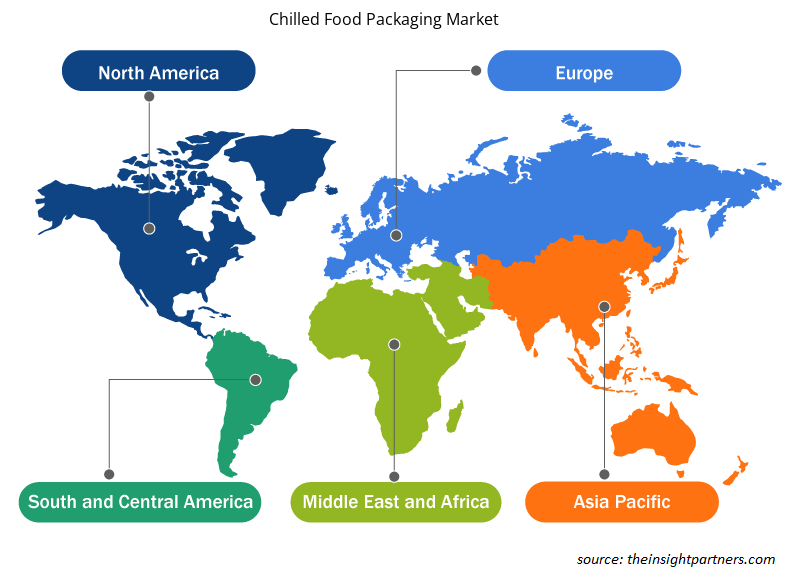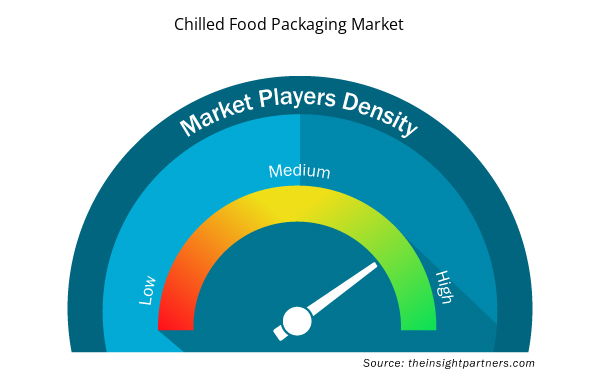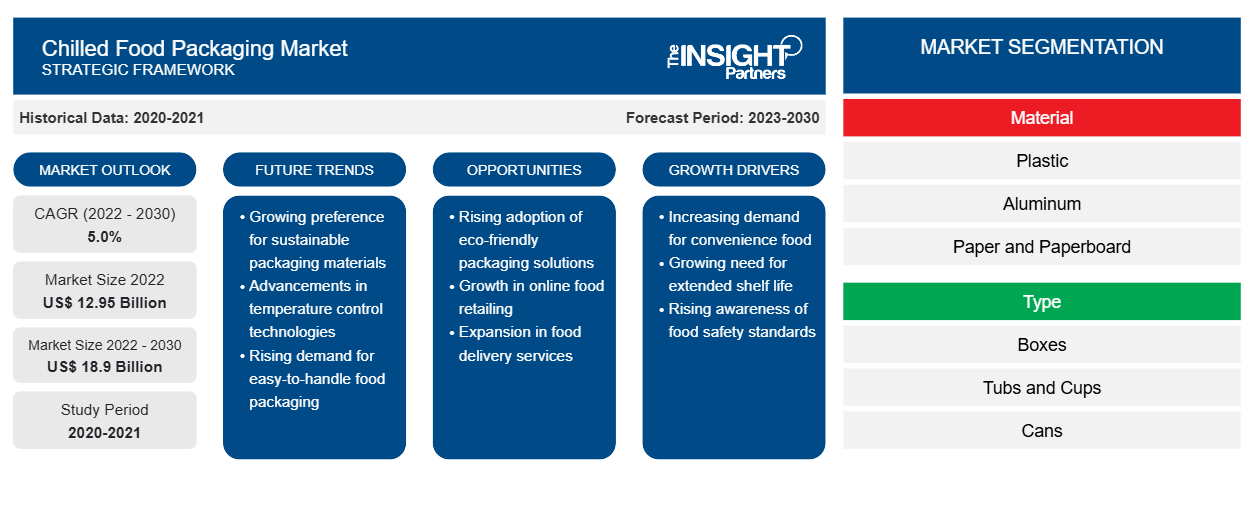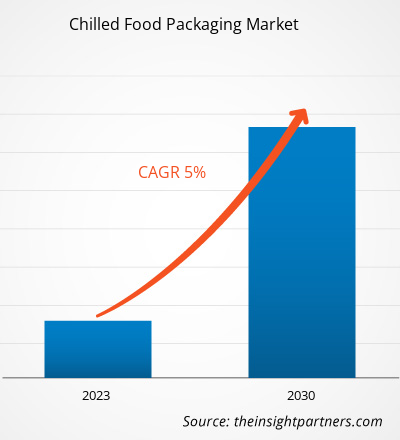[تقرير بحثي] من المتوقع أن ينمو حجم سوق تغليف الأطعمة المبردة من 12،948.11 مليون دولار أمريكي في عام 2022 إلى 18،902.73 مليون دولار أمريكي بحلول عام 2030؛ ومن المتوقع أن يسجل معدل نمو سنوي مركب بنسبة 5.0٪ من عام 2023 إلى عام 2030.
تحليل السوق
يشير سوق تغليف الأطعمة المبردة العالمي إلى تغليف الأطعمة القابلة للتلف والتي تتطلب التبريد للحفاظ على جودتها ونضارتها. يشمل السوق مجموعة من مواد التغليف، مثل البلاستيك والورق والكرتون والألمنيوم والخشب، المصممة للحفاظ على المنتجات الغذائية في درجة حرارة منخفضة أثناء النقل والتخزين. يحرك السوق الطلب المتزايد على الأطعمة الجاهزة، وزيادة التحضر، وتغير أنماط الحياة. كما أن الوعي المتزايد بسلامة الغذاء والنظافة يدفع الطلب على تغليف الأطعمة المبردة. بالإضافة إلى ذلك، من المتوقع أن يؤدي نمو التجارة الإلكترونية والتسوق عبر الإنترنت للبقالة إلى تغذية الطلب على تغليف الأطعمة المبردة خلال فترة التنبؤ.
محركات النمو والتحديات
إن توسع تجارة التجزئة المنظمة والتجارة الإلكترونية يعزز نمو سوق تغليف الأطعمة المبردة العالمية بشكل كبير. توفر منصات تجارة التجزئة المنظمة والتجارة الإلكترونية نطاقًا أوسع ورؤية أكبر لمنتجات الأطعمة المبردة. يفضل المستهلكون بشكل متزايد تنسيقات التجزئة المنظمة بسبب الراحة ومجموعة المنتجات الواسعة التي تقدمها. تقدم تجارة التجزئة المنظمة، مثل محلات السوبر ماركت والهايبر ماركت والمتاجر المتخصصة، مجموعة واسعة من المنتجات ومنتجات الألبان واللحوم والمأكولات البحرية والوجبات الجاهزة للأكل والمزيد. إن راحة وجود منتجات متعددة تحت سقف واحد تجذب المستهلكين وتشجعهم على اختيار تجارة التجزئة المنظمة على تنسيقات التجزئة التقليدية. تتطلب تشكيلة المنتجات المتنوعة تغليفًا مناسبًا لضمان سلامة المنتج ونظافته وتقديمه على أرفف المتاجر. علاوة على ذلك، فإن الزيادة في الطلب على الأطعمة الجاهزة أو المريحة تعمل على تعزيز نمو سوق تغليف الأطعمة المبردة العالمية. يتزايد استهلاك الأطعمة الجاهزة عالية الجودة، وهو ما يعد حاليًا أحد أكبر الاتجاهات في صناعة الأغذية. تسمح الأطعمة الجاهزة، مثل منتجات RTE، للمستهلكين بتوفير الوقت والجهد المرتبطين بالتسوق للحصول على المكونات وإعداد الوجبات والطهي والاستهلاك والأنشطة بعد الوجبة. يُعزى تطوير هذا القطاع الغذائي إلى العديد من التغييرات الاجتماعية؛ ومن أبرزها العدد المتزايد من الأسر الصغيرة وارتفاع عدد سكان الألفية في جميع أنحاء العالم. ومع ذلك، فإن اللوائح الحكومية الصارمة المرتبطة بتغليف الأطعمة المبردة قد تحد من نمو سوق تغليف الأطعمة المبردة. يمكن للوائح الحكومية الصارمة فرض قيود معينة على تغليف الأطعمة المبردة. في حين يتم تنفيذ هذه اللوائح لضمان سلامة المستهلك والاستدامة البيئية، إلا أنها يمكن أن تشكل تحديات وقيودًا لمصنعي وموردي التغليف. غالبًا ما يتطلب الامتثال للمعايير الصارمة استثمارات كبيرة في البحث والاختبار والشهادات ومراقبة الامتثال المستمرة.
قم بتخصيص هذا التقرير ليناسب متطلباتك
ستحصل على تخصيص لأي تقرير - مجانًا - بما في ذلك أجزاء من هذا التقرير، أو تحليل على مستوى الدولة، وحزمة بيانات Excel، بالإضافة إلى الاستفادة من العروض والخصومات الرائعة للشركات الناشئة والجامعات
- احصل على أهم اتجاهات السوق الرئيسية لهذا التقرير.ستتضمن هذه العينة المجانية تحليلاً للبيانات، بدءًا من اتجاهات السوق وحتى التقديرات والتوقعات.
تقسيم التقرير ونطاقه
"تحليل سوق تغليف الأطعمة المبردة العالمية حتى عام 2030" هي دراسة متخصصة ومتعمقة مع التركيز بشكل رئيسي على اتجاهات سوق تغليف الأطعمة المبردة العالمية وفرص النمو. يهدف التقرير إلى تقديم نظرة عامة على سوق تغليف الأطعمة المبردة العالمية مع تقسيم السوق التفصيلي حسب المادة والنوع والتطبيق والجغرافيا. شهد سوق تغليف الأطعمة المبردة العالمية نموًا مرتفعًا خلال الماضي القريب ومن المتوقع أن يستمر هذا الاتجاه خلال فترة التنبؤ. يقدم التقرير إحصائيات رئيسية عن استهلاك تغليف الأطعمة المبردة في جميع أنحاء العالم جنبًا إلى جنب مع الطلب عليها في المناطق والبلدان الرئيسية. بالإضافة إلى ذلك، يقدم التقرير تقييمًا نوعيًا للعوامل المختلفة التي تؤثر على أداء سوق تغليف الأطعمة المبردة في المناطق والبلدان الرئيسية. يتضمن التقرير أيضًا تحليلًا شاملاً للاعبين الرئيسيين في سوق تغليف الأطعمة المبردة وتطوراتهم الاستراتيجية الرئيسية. يتم أيضًا تضمين العديد من التحليلات حول ديناميكيات السوق للمساعدة في تحديد العوامل الدافعة الرئيسية واتجاهات السوق وفرص سوق تغليف الأطعمة المبردة المربحة والتي من شأنها بدورها أن تساعد في تحديد جيوب الإيرادات الرئيسية.
علاوة على ذلك، يوفر تحليل النظام البيئي وتحليل القوى الخمس لبورتر رؤية بزاوية 360 درجة لسوق تغليف الأطعمة المبردة العالمية، مما يساعد على فهم سلسلة التوريد بأكملها والعوامل المختلفة التي تؤثر على نمو السوق.
التحليل القطاعي
يتم تقسيم سوق تغليف الأطعمة المبردة العالمية على أساس المادة والنوع والتطبيق. بناءً على المادة، يتم تقسيم سوق تغليف الأطعمة المبردة إلى البلاستيك والألمنيوم والورق والكرتون وغيرها. بناءً على النوع، يتم تقسيم سوق تغليف الأطعمة المبردة إلى الصناديق والأحواض والأكواب والعلب والأكياس والحقائب وغيرها. بناءً على التطبيق، يتم تقسيم سوق تغليف الأطعمة المبردة إلى منتجات الألبان واللحوم والدواجن والمأكولات البحرية والفواكه والخضروات وغيرها. بناءً على المادة، شكلت شريحة البلاستيك أكبر حصة في سوق تغليف الأطعمة المبردة العالمية. البلاستيك هو المادة الأكثر تفضيلاً لتغليف المنتجات المبردة. التغليف البلاستيكي هو شكل مرن من أشكال التغليف، مما يسمح لمقدمي خدمات الطعام بتخصيص شكله وأسلوبه وحجمه وفقًا لمتطلبات العملاء. التغليف البلاستيكي مفضل في صناعة خدمات الطعام لأنه خفيف الوزن. علاوة على ذلك، فإن منتجات التغليف البلاستيكية المستخدمة في تغليف الأطعمة سهلة النقل. نظرًا لمتانتها ومقاومتها للتأثيرات الخارجية، فإنها تساعد في الحفاظ على منتجات الأطعمة المعبأة المبردة. غالبًا ما يتم تعبئة الحلويات المبردة والوجبات الجاهزة ومنتجات الألبان واللحوم والمأكولات البحرية وأطباق المعكرونة والدواجن والفواكه والخضروات في مواد بلاستيكية أو مواد بلاستيكية. بناءً على النوع، احتل قطاع الأكياس والحقائب أكبر حصة في سوق تغليف الأطعمة المبردة في عام 2022. يتم تصنيع الأكياس والحقائب من مواد مثل الرقائق والبلاستيك الصالح للأكل. يتم استخدامها في الغالب لتغليف الخضروات المجمدة واللحوم والمأكولات البحرية والأطعمة الأخرى. وهي مفضلة بسبب وزنها الخفيف وصغر حجمها. بناءً على التطبيق، شكل قطاع منتجات الألبان حصة كبيرة في سوق تغليف الأطعمة المبردة العالمية. غالبية منتجات الألبان قابلة للتلف. هناك حاجة إلى أنواع عديدة من مفاهيم التغليف لتعبئة أنواع مختلفة من منتجات الألبان. أدى الطلب على منتجات الألبان المختلفة إلى تحسينات في العمليات ومفاهيم التغليف، مما يزيد بشكل كبير من العمر الافتراضي لمنتجات الألبان في توزيع سلسلة التبريد. يتم تعبئة الأطعمة المبردة للحفاظ على المنتجات الغذائية طازجة وللحماية من العوامل الخارجية، مثل تغيرات درجات الحرارة والرطوبة والبخار. سيؤدي هذا إلى جذب المزيد من فرص النمو الجديدة لنمو الصناعة بشكل عام.
التحليل الإقليمي
يقدم التقرير نظرة عامة مفصلة على سوق تغليف الأطعمة المبردة العالمية فيما يتعلق بخمس مناطق رئيسية - أمريكا الشمالية وأوروبا وآسيا والمحيط الهادئ (APAC) والشرق الأوسط وأفريقيا (MEA) وأمريكا الجنوبية والوسطى. استحوذت منطقة الشرق الأوسط وأفريقيا على حصة كبيرة من السوق؛ حيث قُدرت قيمة السوق في الشرق الأوسط وأفريقيا بأكثر من 700 مليون دولار أمريكي في عام 2022 ومن المتوقع أن تشهد نموًا كبيرًا خلال الفترة المتوقعة. ساهم الارتفاع السريع في التجارة الإلكترونية بشكل إيجابي في نمو السوق في الشرق الأوسط وأفريقيا. كما شهدت منطقة آسيا والمحيط الهادئ نموًا كبيرًا؛ ومن المتوقع أن يصل السوق إلى أكثر من 5 مليارات دولار أمريكي في عام 2030، ويعزى ذلك إلى الطلب المتزايد من التجارة الإلكترونية وتجارة التجزئة المنظمة لتغليف الأطعمة المبردة. ومن المتوقع أن ينمو سوق تغليف الأطعمة المبردة في أمريكا الشمالية بمعدل نمو سنوي مركب يزيد عن 5٪؛ ومن المتوقع أن يؤدي التفضيل المتزايد للأطعمة الجاهزة للأكل إلى تعزيز نمو سوق تغليف الأطعمة المبردة في أمريكا الشمالية.
تطورات الصناعة والفرص المستقبلية
وُجِد أن الشراكات والاستحواذات وإطلاق المنتجات الجديدة هي الاستراتيجيات الرئيسية التي يتبناها اللاعبون العاملون في سوق تغليف الأغذية المبردة العالمية.
في مايو 2023، دخلت شركة Graphic Packaging في شراكة مع شركة Cranswick Plc لتسويق عبوة PaperLite القابلة لإعادة التدوير لصالح شركة Tesco Plc.
في أبريل 2020، أعلنت Elopak وGLS عن مشروع مشترك حيث ستمتلك كل منهما 50% من أسهمه. ستستفيد الشركة التي تم تشكيلها حديثًا، GLS Elopak، من الخبرة والأصول والشبكات الخاصة بـ Elopak وGLS للاستفادة من الطلب الاستهلاكي الكبير في الهند.
رؤى إقليمية حول سوق تغليف الأطعمة المبردة
لقد قام المحللون في Insight Partners بشرح الاتجاهات والعوامل الإقليمية المؤثرة على سوق تغليف الأطعمة المبردة طوال فترة التوقعات بشكل شامل. يناقش هذا القسم أيضًا قطاعات سوق تغليف الأطعمة المبردة والجغرافيا في جميع أنحاء أمريكا الشمالية وأوروبا ومنطقة آسيا والمحيط الهادئ والشرق الأوسط وأفريقيا وأمريكا الجنوبية والوسطى.

- احصل على البيانات الإقليمية المحددة لسوق تغليف الأطعمة المبردة
نطاق تقرير سوق تغليف الأطعمة المبردة
| سمة التقرير | تفاصيل |
|---|---|
| حجم السوق في عام 2022 | 12.95 مليار دولار أمريكي |
| حجم السوق بحلول عام 2030 | 18.9 مليار دولار أمريكي |
| معدل النمو السنوي المركب العالمي (2022 - 2030) | 5.0% |
| البيانات التاريخية | 2020-2021 |
| فترة التنبؤ | 2023-2030 |
| القطاعات المغطاة | حسب المادة
|
| المناطق والدول المغطاة | أمريكا الشمالية
|
| قادة السوق وملفات تعريف الشركات الرئيسية |
|
كثافة اللاعبين في سوق تغليف الأطعمة المبردة: فهم تأثيرها على ديناميكيات الأعمال
يشهد سوق تغليف الأطعمة المبردة نموًا سريعًا، مدفوعًا بالطلب المتزايد من المستخدم النهائي بسبب عوامل مثل تفضيلات المستهلكين المتطورة والتقدم التكنولوجي والوعي المتزايد بفوائد المنتج. ومع ارتفاع الطلب، تعمل الشركات على توسيع عروضها والابتكار لتلبية احتياجات المستهلكين والاستفادة من الاتجاهات الناشئة، مما يؤدي إلى زيادة نمو السوق.
تشير كثافة اللاعبين في السوق إلى توزيع الشركات أو المؤسسات العاملة في سوق أو صناعة معينة. وهي تشير إلى عدد المنافسين (اللاعبين في السوق) الموجودين في مساحة سوق معينة نسبة إلى حجمها أو قيمتها السوقية الإجمالية.
الشركات الرئيسية العاملة في سوق تغليف الأغذية المبردة هي:
- شركة موندي المحدودة
- شركة أمكور المحدودة
- شركة سيلستريب
- شركة سونوكو للمنتجات
- اميربلاست المحدودة
إخلاء المسؤولية : الشركات المذكورة أعلاه ليست مرتبة بأي ترتيب معين.

- احصل على نظرة عامة على أهم اللاعبين الرئيسيين في سوق تغليف الأطعمة المبردة
تأثير كوفيد/ تأثير السيناريو الجيوسياسي/ تأثير الركود
أدى جائحة كوفيد-19 إلى تراجع تقدم العديد من الصناعات في جميع أنحاء العالم. أدى إغلاق مصانع التصنيع والتجارة المقيدة في جميع أنحاء العالم إلى قيود على سلسلة التوريد للمصنعين في جميع أنحاء العالم. أثر جائحة كوفيد-19 سلبًا على نمو قطاع المواد الكيميائية والمواد وسوق تغليف الأطعمة المبردة. أعاق تنفيذ التدابير لمكافحة انتشار فيروس سارس-كوف-2 نمو الصناعات المختلفة. تسبب الوباء في حدوث اضطرابات في سلسلة التوريد العالمية بسبب إغلاق المصانع وقيود النقل ونقص العمالة. أثرت هذه الاضطرابات على توافر المواد الخام ومكونات التعبئة والتغليف، مما أدى إلى تأخيرات محتملة في سلسلة التوريد وزيادة تكاليف التشغيل لمصنعي تغليف الأطعمة المبردة. ساهم ندرة المواد الخام وارتفاع تكاليف النقل في ارتفاع تكاليف الإنتاج. بالإضافة إلى ذلك، شهد قطاع خدمات الأغذية، بما في ذلك المطاعم والمقاهي وخدمات تقديم الطعام، انخفاضًا حادًا في الطلب بسبب عمليات الإغلاق وتدابير التباعد الاجتماعي. أثر هذا الانخفاض بشكل مباشر على الطلب على المنتجات الغذائية المبردة والتعبئة والتغليف المرتبطة بها في عمليات خدمة الأغذية. ونتيجة لذلك، واجه مصنعو مواد التعبئة والتغليف العاملة في قطاع خدمات الأغذية انخفاضًا في الطلبات وخسارة في الإيرادات. ومع ذلك، فقد تعافى سوق تغليف الأطعمة المبردة بشكل جيد للغاية من آثار الوباء، ومن المتوقع أن ينمو خلال السنوات القادمة.
المشهد التنافسي والشركات الرئيسية
بعض اللاعبين الرئيسيين الذين يعملون في سوق تغليف الأطعمة المبردة هم Mondi Plc؛ Amcor Plc؛ Sealstrip Corp؛ Sonoco Products Co؛ Amerplast Ltd؛ Berry Global Group Inc؛ Westrock Co؛ Graphic Packaging Holding Co؛ Tetra Pak International SA؛ وSealed Air Corp.
- التحليل التاريخي (سنتان)، السنة الأساسية، التوقعات (7 سنوات) مع معدل النمو السنوي المركب
- تحليل PEST و SWOT
- حجم السوق والقيمة / الحجم - عالميًا وإقليميًا وقطريًا
- الصناعة والمنافسة
- مجموعة بيانات Excel



Report Coverage
Revenue forecast, Company Analysis, Industry landscape, Growth factors, and Trends

Segment Covered
This text is related
to segments covered.

Regional Scope
North America, Europe, Asia Pacific, Middle East & Africa, South & Central America

Country Scope
This text is related
to country scope.
الأسئلة الشائعة
The major players operating in the global chilled food packaging market are Mondi Plc; Amcor Plc; Sealstrip Corp; Sonoco Products Co; Amerplast Ltd; Berry Global Group Inc; Westrock Co; Graphic Packaging Holding Co; Tetra Pak International SA; and Sealed Air Corp.
North America accounted for the largest share of the global chilled food packaging market. North America is one of the most significant regions for the chilled food packaging market owing to drastic increase in the consumption of ready-to-eat food.
Organized retail and e-commerce platforms provide a broader reach and greater visibility for chilled food products. Consumers increasingly prefer organized retail formats due to the convenience and wide range of products they offer. Organized retail, such as supermarkets, hypermarkets, and specialty stores, offers a wide range of produce, dairy products, meat, seafood, ready-to-eat (RTE) meals, and more. The convenience of having multiple products under one roof attracts consumers and encourages them to choose organized retail over traditional retail formats. The diverse product assortment requires appropriate packaging to ensure product integrity, hygiene, and presentation on store shelves. dditionally, chilled food packaging helps extend the shelf life of perishable products by providing protective barriers against oxygen, moisture, and contaminants. Hence, retailers can stock various chilled food items for longer periods, lowering the risk of spoilage and minimizing product waste. Proper packaging enables retailers to offer fresh and high-quality products to consumers.
Consumers demand safe and low-processed food; thus, chilled food packaging players are making significant changes in packaging solutions. Also, there are growing environmental concerns. In Canada, many cities have banned the distribution of polystyrene foam cups and containers because end users are seeking sustainable solutions. Vancouver (Canada) also restricts plastic shopping bags and disposable cups. The Canadian packaging industry promotes major food packaging projects aiming to ensure 100% recyclable, reusable, or compostable packaging solutions. Further, eco-friendly packaging helps protect human health and the environment and maintain natural resources. Ideal packaging material should possess recycling properties, serving as a viable solution for ecological issues. Food service packaging companies are seeking ways to recycle as part of their efforts toward finding sustainable food packaging solutions.
Based on the application, meat and poultry segment is projected to grow at the fastest CAGR over the forecast period. Meat and poultry foods are perishable products, and the packaging of chilled meat and poultry products is crucial in food safety programs. Atmosphere-appropriate packaging is widely used for protecting chilled meat and poultry products. Beef, lamb, pork, and chicken must be kept below +5°C. Plastic bags, cartons, wraps, and films are majorly utilized for packaging meat and poultry products.
Based on material, plastic segment mainly has the largest revenue share. The growth of the segment is attributed to the excellent properties of the plastic as packaging material. Plastic is the most preferred material for packaging refrigerated products. Plastic packaging is a flexible form of packaging, allowing food service providers to customize its shape, style, and size as per customers’ requirements. Plastic packaging is preferred in the food service industry since it is lightweight.
Trends and growth analysis reports related to Chemicals and Materials : READ MORE..
The List of Companies - Chilled Food Packaging Market
- Mondi Plc
- Amcor Plc
- Sealstrip Corp
- Sonoco Products Co
- Amerplast Ltd
- Berry Global Group Inc
- Westrock Co
- Graphic Packaging Holding Co
- Tetra Pak International SA
- Sealed Air Corp
The Insight Partners performs research in 4 major stages: Data Collection & Secondary Research, Primary Research, Data Analysis and Data Triangulation & Final Review.
- Data Collection and Secondary Research:
As a market research and consulting firm operating from a decade, we have published and advised several client across the globe. First step for any study will start with an assessment of currently available data and insights from existing reports. Further, historical and current market information is collected from Investor Presentations, Annual Reports, SEC Filings, etc., and other information related to company’s performance and market positioning are gathered from Paid Databases (Factiva, Hoovers, and Reuters) and various other publications available in public domain.
Several associations trade associates, technical forums, institutes, societies and organization are accessed to gain technical as well as market related insights through their publications such as research papers, blogs and press releases related to the studies are referred to get cues about the market. Further, white papers, journals, magazines, and other news articles published in last 3 years are scrutinized and analyzed to understand the current market trends.
- Primary Research:
The primarily interview analysis comprise of data obtained from industry participants interview and answers to survey questions gathered by in-house primary team.
For primary research, interviews are conducted with industry experts/CEOs/Marketing Managers/VPs/Subject Matter Experts from both demand and supply side to get a 360-degree view of the market. The primary team conducts several interviews based on the complexity of the markets to understand the various market trends and dynamics which makes research more credible and precise.
A typical research interview fulfils the following functions:
- Provides first-hand information on the market size, market trends, growth trends, competitive landscape, and outlook
- Validates and strengthens in-house secondary research findings
- Develops the analysis team’s expertise and market understanding
Primary research involves email interactions and telephone interviews for each market, category, segment, and sub-segment across geographies. The participants who typically take part in such a process include, but are not limited to:
- Industry participants: VPs, business development managers, market intelligence managers and national sales managers
- Outside experts: Valuation experts, research analysts and key opinion leaders specializing in the electronics and semiconductor industry.
Below is the breakup of our primary respondents by company, designation, and region:

Once we receive the confirmation from primary research sources or primary respondents, we finalize the base year market estimation and forecast the data as per the macroeconomic and microeconomic factors assessed during data collection.
- Data Analysis:
Once data is validated through both secondary as well as primary respondents, we finalize the market estimations by hypothesis formulation and factor analysis at regional and country level.
- Macro-Economic Factor Analysis:
We analyse macroeconomic indicators such the gross domestic product (GDP), increase in the demand for goods and services across industries, technological advancement, regional economic growth, governmental policies, the influence of COVID-19, PEST analysis, and other aspects. This analysis aids in setting benchmarks for various nations/regions and approximating market splits. Additionally, the general trend of the aforementioned components aid in determining the market's development possibilities.
- Country Level Data:
Various factors that are especially aligned to the country are taken into account to determine the market size for a certain area and country, including the presence of vendors, such as headquarters and offices, the country's GDP, demand patterns, and industry growth. To comprehend the market dynamics for the nation, a number of growth variables, inhibitors, application areas, and current market trends are researched. The aforementioned elements aid in determining the country's overall market's growth potential.
- Company Profile:
The “Table of Contents” is formulated by listing and analyzing more than 25 - 30 companies operating in the market ecosystem across geographies. However, we profile only 10 companies as a standard practice in our syndicate reports. These 10 companies comprise leading, emerging, and regional players. Nonetheless, our analysis is not restricted to the 10 listed companies, we also analyze other companies present in the market to develop a holistic view and understand the prevailing trends. The “Company Profiles” section in the report covers key facts, business description, products & services, financial information, SWOT analysis, and key developments. The financial information presented is extracted from the annual reports and official documents of the publicly listed companies. Upon collecting the information for the sections of respective companies, we verify them via various primary sources and then compile the data in respective company profiles. The company level information helps us in deriving the base number as well as in forecasting the market size.
- Developing Base Number:
Aggregation of sales statistics (2020-2022) and macro-economic factor, and other secondary and primary research insights are utilized to arrive at base number and related market shares for 2022. The data gaps are identified in this step and relevant market data is analyzed, collected from paid primary interviews or databases. On finalizing the base year market size, forecasts are developed on the basis of macro-economic, industry and market growth factors and company level analysis.
- Data Triangulation and Final Review:
The market findings and base year market size calculations are validated from supply as well as demand side. Demand side validations are based on macro-economic factor analysis and benchmarks for respective regions and countries. In case of supply side validations, revenues of major companies are estimated (in case not available) based on industry benchmark, approximate number of employees, product portfolio, and primary interviews revenues are gathered. Further revenue from target product/service segment is assessed to avoid overshooting of market statistics. In case of heavy deviations between supply and demand side values, all thes steps are repeated to achieve synchronization.
We follow an iterative model, wherein we share our research findings with Subject Matter Experts (SME’s) and Key Opinion Leaders (KOLs) until consensus view of the market is not formulated – this model negates any drastic deviation in the opinions of experts. Only validated and universally acceptable research findings are quoted in our reports.
We have important check points that we use to validate our research findings – which we call – data triangulation, where we validate the information, we generate from secondary sources with primary interviews and then we re-validate with our internal data bases and Subject matter experts. This comprehensive model enables us to deliver high quality, reliable data in shortest possible time.


 احصل على عينة مجانية لهذا التقرير
احصل على عينة مجانية لهذا التقرير